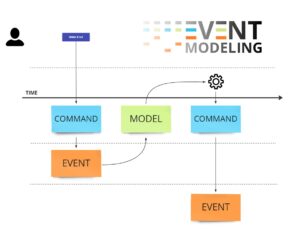In the hyper-speed realm of software development, the balance between detailed planning and flexible execution is a delicate art. Too often, teams are confronted with heavy weight processes, which stifles agility and introduces delays, while over-burdened teams move forward with minimal planning, which often leads to ambiguity and misaligned expectations and introduces delays. This is where Event Modeling emerges as an efficient and balanced approach, using just enough design which focuses on the two fundamental pieces of every information system; empowering the user and informing the user. This approach produces a system blueprint that sets expectations, provides clarity, enables agility, and will diminish software related delays over time.
The Essence of Event Modeling
Event Modeling isn’t yet another design methodology; it’s a practical approach the helps team members understand the project better, regardless of their role. It avoids the problems of too much or too little planning by illustrating how users and other systems interact with the system to produce events, and how reactions to these events empower users to perform complex tasks with ease while keeping them informed throughout their workflows.
This methodology effectively addresses the needs of diverse teams:
For software engineers, it lays out the technical specifics that govern system behaviors and interactions.
For software architects, it defines a system in terms of its capabilities rather than its technologies.
For quality assurance, it defines the nuances of the system using given-when-then style specifications.
For user interface designers, it presents a pages and components using wireframes and light weight mock ups.
For user experience designers, it presents a visual storyboard, detailing the user interactions that trigger system events.
For project managers, it can be used to track the implementation progress, changes, and risks.
For product managers, it illustrates a wholistic view of the process flows that drive the application and deliver value.
Aligning Development with Business Objectives
One of the standout features of Event Modeling is its ability to align development efforts with business goals. By breaking down systems into vertical slices of functionality—represented by one of four patterns—Event Modeling ensures that every piece adds tangible value. This modular approach not only aligns with strategic business objectives but also enhances understandability across the board.
Making Teamwork More Efficient
In many development environments, team members often find their work inadvertently entangled with that of their colleagues, leading to bottlenecks and dependencies that delay delivery. Event Modeling sidesteps these challenges by defining discrete, self-contained vertical slices of functionality that are additive, enabling team members to work independently.
This structure fosters an environment where parallel development is not just possible but thrives. Developers can focus on their segments of the model without the constant need for coordination on every detail, significantly reducing the overhead of communication and conflict resolution. This autonomy also allows for more accurate and straightforward tracking of project progression.
Integration with Project Management
Adopting Event Modeling doesn’t mean abandoning your project management tools. Whether your team is using Jira, Azure DevOps, or any other project management system, Event Models can be translated and tracked. This ensures that the business can continue using the tools that work best for them while reaping the benefits of Event Modeling. If your organization is not tightly coupled to a project management system, progress can be tracked directly on the Event Model.
A Blueprint for Successful Modern Development
Event Modeling is more than just a way to design systems—it’s a holistic approach that enhances team collaboration, accelerates development, and aligns projects closely with business outcomes. By balancing detailed technical planning with high-level process visibility, it serves as an ideal format for teams striving to innovate rapidly while maintaining clarity and cohesion in their projects and the organization.
As businesses continue to navigating the complexities of evergreen digital transformations, adopting Event Modeling could be the key to staying responsive.
Ask how Axian can help get you started with Event Modeling.
Learn More
Event Modeling: What is it? by Adam Dymitruk, the creator of Event Modeling.
Event Modeling Traditional Systems by Adam Dymitruk
Practical Event Modeling a video series by Bobby Calderwood, founder of EvidentStack.com
